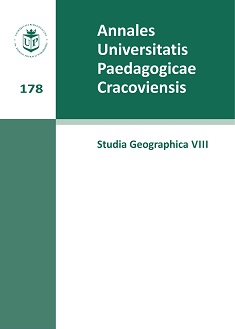The paradoxical place of small towns in sustainable development policies. What is beyond the images of “places where the living is easy”?
Słowa kluczowe:
rozwój, obrazy, polityka, małe miasta, zrównoważonyAbstrakt
Sustainable development policies have become new objectives of local actions since the implementation of the notion in the 1990s. Small towns promote images of places where the living is easy and with sustainable amenities like “natural” living environment. But, beyond these perceptions, operational sustainable development policies are quite occasional. Taking a sample of French small towns in the Auvergne region as examples, it is interesting to analyse this paradox of an interesting potential leading to rare effective actions. It seems that it is quite difficult for local stakeholders to implement really transversal and not sectoral policies and the lack of capacity and budget is an important issue for them as it takes time and money to develop really participative and holistic programs.Bibliografia
Bell, D., Jayne, M. (2009). Small cities? Towards a research agenda. International Journal of Urban and Regional Research, 33(3), 683–699.
Dooris, M. (1999). Healthy Cities and Local Agenda 21: the UK experience-challenges for the new millennium. Health promotion international. Oxford: 14(4), 365–375.
Filimon, L., Petrea, R., Filimon, C., Nemes, V. (2013). Les «ţări» roumains: des territoires de projet au service du développement territorial durable? In: La mise en oeuvre du développement territorial durable: déclinaisons franco-roumaines. Paris: Editions L’Harmattan.
Grzelak-Kostulska, E., Hołowiecka, B., Kwiatkowski, G. (2011). Cittaslow International Network: An Example of a Globalization Idea? In: The Scale of Globalization. Think Globally, Act Locally, Change Individually in the 21st Century, 186–192. Ostrava: University of Ostrava.
Knox, P., Mayer, H. (2009). Small Town Sustainability: Economic, Social, and Environmental Innovation. Birkhauser Verlag AG, Basel, Switzerland, Berlin, Germany, and Boston, MA.
Kostrzewa, K., Piasecki, R. (2009). Approaches to Sustainable Development in Poland. L’Europe en Formation, 2(352), 181–196.
Kusis, J., Abele, J. (2008). Development strategies of small towns as the basis of sustainability. In: V. Majerová (ed.), Countryside – our world. Praha: Česká zemědělská univerzita, 371–379.
Kwiatek-Sołtys, A. (2004). Małe miasta województwa małopolskiego w okresie transformacji systemowej. Kraków: Wyd. Akademii Pedagogicznej.
Kwiatek-Sołtys, A., Mainet, H. (2014). Quality of life and attractiveness of small towns: a comparison of France and Poland. Quaestiones Geographicae 33(2), 103–113.
Lampić, B., Špes, M. (2007). Sustainable development of small towns. Ljubljana: Univerza v Ljubljani.
Le Goff, E., Séchet, R. (2011). Les villes-santé et le développement durable: convergence, concurrence ou écran? L’Information géographique, 2(75), 99–99.
Mainet, H. (2011). Les petites villes françaises en quête d’identité: ambigüité du positionnement ou image tactiquement combinée? MOTS, Les langages du politique, ENS Editions, n°97, novembre 2011, 75–89.
Navez-Bouchanine, F. (2007). Le développement urbain durable: «best practice» ou leurre méthodologique? Espaces et sociétés, 4(131), 101–116.
Pumain, D. (1999). Quel rôle pour les villes et moyennes des régions périphériques. Revue de Géographie Alpine, 2, 169–184.
Vaishar, A., Greer-Wootten, B. (2006). Sustainable development in Moravia: an interpretation of the role of the small-town sector in transitional socioeconomic evolution. In: Z. Bochniarz, G.B. Cohen, (eds.), The environment and sustainable development in the new central Europe. New York–Oxford: Berghahn Books, 217–231.
Waitt, G.R., Gibson, C.R. (2006). Creative small cities: Rethinking the creative economy in place. Urban Studies, 46(5), 1223–1246.
www.ecoquartiers.developpement-durable.gouv.fr
Pobrania
Opublikowane
Numer
Dział
Licencja
Złożenie artykułu do druku oznacza wyrażenie zgody na bezpłatne (tj. bez honorariów autorskich) przeniesienie autorskich praw majątkowych na Wydawcę i zezwolenie na wydanie pracy w postaci drukowanej w dowolnej liczbie egzemplarzy oraz zamieszczenie jej w postaci otwartego dostępu na stronie internetowej czasopisma, w bibliotekach cyfrowych oraz innych cyfrowych platformach wydawniczych, z którymi Wydawca zawarł lub zawrze stosowne porozumienie o udostępnianiu. W przypadku artykułów wieloautorskich przyjmuje się, że autor zgłaszający pracę („correspondingauthor”) ma pełnomocnictwo do reprezentowania pozostałych współautorów w tym zakresie. Autorzy są proszeni o podpisanie stosownego oświadczenia w tej sprawie.

